
by Maureen | Jul 24, 2014 | 2014, Eye on Culture, Indonesia, Scoops of Joy, World Motherhood

An Indonesian father with child
Would you believe me if I tell you I have NEVER heard of Father’s Day until I moved to America in 2005.
Yes, true story!
Here in Indonesia we just simply don’t have Father’s Day.
We do have Mother’s Day on December 22, 2014. The holiday is celebrated on the anniversary of the opening day of the first Indonesian Women Congress, which was held from 22 to 25 December 1928. The Congress was attended by 30 feminist organizations from 12 cities in Java and Sumatra. In Indonesia, feminist organizations have existed since 1912, inspired by Indonesian heroines of the 19th century, e.g., Kartini, Martha Christina Tiahahu, Cut Nyak Meutia, Maria Walanda Maramis, Dewi Sartika, Nyai Ahmad Dahlan, Rasuna Said, etc. The Congress intended to improve women’s rights in education and marriage.
We also have Kartini Day on 21 April to celebrate the emancipation of women spearheaded by an activist, Raden Ajeng Kartini.
So why do we have no Father’s Day then?
Could it be because we as a country are already too patriarchy?
I actually wonder about that too. So like a good citizen, I turned to Google and did a little research.
What do you know, actually we do have one and it’s called “Hari Ayah” in Indonesian which means Father’s Day. It was declared in 2006 it falls on 12 November. That explains why very few people are aware of this and it’s not popular. Maybe because we don’t commercialize it as much as mother’s day? I have never seen an advertisement for local Father’s Day.
Technically, men still perceived to have higher place than women in Indonesia. Like it or not, that’s the truth. We are still plagued by social injustices caused by a male-dominated society that abandons women to the whims of their husbands. So maybe that’s why it is more ‘common’ to celebrate Mother’s Day.
Being from a whole intact family unit of a father and a mother doesn’t guarantee that the father is always hands-on, and I think this happens in many different countries, too. I have personally seen mentally checked out fathers who leave all the responsibilities of raising children solely to their wives by justifying they are too busy making a living for the family. Many men still believe their fatherhood role is simply to provide for the family and that’s it. I feel for women who literally are acting as single parents in a married-life.
Being a mother myself, I can truly appreciate a man who helps out his wife. I celebrate hands-on fathers, like my own father. My father is a strong dominant male figure to me and many people will be surprised by how hands-on he has been. I can still recall him changing my brothers’ diapers, doing the dishes (something he still does to this very day!) and other domestic chores without complaining, going to the market for my mother and many more. He was even actively involved in our schools’ boards. He works hard, yet, he was and is always there.
And now seeing my own younger brother being very hands-on in caring, raising his first daughter truly warms my heart. My sister-in-laws’ friends pointed out that their own husbands do not even want to change diapers, but my brother changes diapers and more.
This made me realize how lucky we are to have our father as a big role model who set great living standards of what a great father is like.
So although Father’s Day is not hugely popular here, I salute all men who break the stereotype of fatherhood in my country. Hats off to you!
When do you celebrate Father’s Day in your country? How do you celebrate Father’s Day?
This is an original post by our World Mom, Maureen of “Scoops of Joy” in Indonesia for World Moms Blog.
Photo Credit: http://www.stockvault.net/photo/152311/asian-child-with-father

by Susan Koh | Jun 26, 2014 | 2014, Life Balance, Me-Time, Motherhood, Singapore, Susan Koh, Working Mother, World Motherhood

Keeping The Joy
I may be a working mom balancing between family and work, but I’m certainly no super mom. In Singapore, where the population is not reproducing fast enough, our government has gone to great lengths to encourage couples to get married and start a family. And after the ladies have given birth, they are encouraged to return to the work force, as human capital is pretty much our only “resource” in the nation. So like a huge majority of women, I took on a role as a full-time working mom and promptly returned to work after my maternity leave ended after four months.
Unlike most parents who leave their child in the care of their parents or in-laws, my daughter, Sophie, went to infant care at merely four months old. This was after weighing our options very carefully then, as we didn’t live with or near our parents, and we didn’t want to have a live-in helper or nanny. It wasn’t easy initially, and I can’t even remember how many sleepless nights I had when I questioned if I made the right decision to return to work, especially when Sophie fell ill or when I saw her cry when I dropped her off at the childcare center. But today, when I see how Sophie has blossomed to an independent, sociable and sensible pre-schooler, it makes me feel happy that she’s turned out better than what we prayed for and expected.
Being a working mom certainly has its challenges and the one that tops the list for me is not having enough time in a day. So here are some tips on how I manage it without losing my joy.

You Can Do Anything
Be fully present
Once I am back from work, I’m 100% devoted to being a mom. I’m thankful that I have supportive bosses and colleagues who understand this, so they never make demands that I have to put in extra hours unless it’s crunch time in the office.
You know what they say about quality time being more important than quantity time? And for working moms it’s so true because, otherwise, we’ll always be beating ourselves up about the lack of time spent with our kids. Screen time is kept to a minimum, so that we spend good quality time together.
And maybe because Sophie is a girl, we enjoy spending time before bedtime sharing how our day went, reading books or even playing games when we feel up to it. But I’ll be totally honest and also say that we do use the TV and iPad as a nanny at times, especially when we have chores to do or when we ourselves just want a mental break on exhausting days.
Train your kids to be independent
With no help at home, Sophie is naturally trained to pick up after herself. When she was younger, we’ll give her little rewards like stickers as an incentive when she keeps her toys, folds the laundry and takes her dishes to the kitchen.
As she gets older, she’s learned that she has a responsibility to help around the house. Of course, I’ll still reward her with praises and appreciation, and she’s come to learn that she needs to do so without expecting anything in return. And these days, she’s on auto pilot-mode and will chip in around the house.
Manage your expectations
I used to strive to do everything perfectly as a mom and had a problem letting go. But when you only have that many hours in a day, I’ve learnt that I need to let go if I want to keep my sanity and my joy. So that means, closing an eye to the unfolded laundry, the times when I can’t cook dinner for the family, the mess at home, and yes, even the dirt at home.
I could get hung up about all these things and stay up late into the night to finish the chores and start the whole routine again the next day, but I know I’ll also feel very miserable and start to loathe it all. So my mantra is simply to do what’s necessary and be happy. After all, as moms, we can do anything but not everything.
Besides, when I get stressed over all the chores, my husband hears no end of complaining and which husband appreciates that? So for him, his mantra is, a happy wife, a happy life.
Schedule me-time
I know it’s crazy to even think that working moms even have any me-time. But it is absolutely crucial to find time for myself to recharge. My me-time can be anything from going for a jog, to having a nice haircut, or even a catch up session with my girlfriends. This year, I’ve started a new hobby, Project Life, and it’s so therapeutic to look back at my life in photos and pen down the memories behind them. Plus, it’s a way of recording life so that nothing slips by and a reminder for me to cherish every moment.
So there you have it – some of my sanity tips for working moms on how to keep your joy. It’s not easy being a working mom, and I know that the person who makes it possible is my dearest hubby who is ever supportive of my decision. He’s every bit the modern husband and daddy in the 21st century who is not afraid to roll up his sleeves to do his part in parenting but also to chip in around the house. And while, he shakes his head when I tell him I still have hopes to be a domestic goddess, I know he’s glad that I’m working to bring in the dough for the family so that we can enjoy our family holidays and have my own shopping money and savings.
Are you a working mom too? If so, what are your top tips to keeping your joy as a working mom?
This is an original post by Susan Koh for World Moms Blog. She’s loves to travel and blogs passionately about parenting, marriage and relationship and leading a healthy life at www.ajugglingmom.com.
Photo credit to the author.
Susan is from Singapore. As a full-time working mom, she's still learning to perfect the art of juggling between career and family while leading a happy and fulfilled life. She can't get by a day without coffee and swears she's no bimbo even though she likes pink and Hello Kitty. She's loves to travel and blogs passionately about parenting, marriage and relationship and leading a healthy life at A Juggling Mom.
More Posts

by Karyn Wills | Jun 23, 2014 | 2014, Awareness, Being Thankful, Brothers, Childhood, Culture, Education, Eye on Culture, Kids, Multicultural, Music, Nature, New Zealand, School, Siblings, Traditions, World Motherhood
 It’s mid-winter in New Zealand. The air is crisper than I’ve felt it for a while, the leaves have pretty much fallen and we have had the shortest day of the year.
It’s mid-winter in New Zealand. The air is crisper than I’ve felt it for a while, the leaves have pretty much fallen and we have had the shortest day of the year.
This week also saw the appearance of the star cluster, Matariki, (The Pleiades), which heralds the Maori New Year.
This was not a festival I had ever heard of growing up but it has been revised and reinstated and there are now celebrations being held all around New Zealand. While different tribes traditionally celebrated Matariki in their own fashion, now it is universally marked by the new moon and rising of the Matariki star cluster with festivities running from 1st June to 30th July.
Traditionally, Matariki was a time of celebration, important for navigation and the timing of the seasons. It was particularly relevant to the preparation of the ground for the upcoming growing season and offerings to the gods, and specifically, Rongo, the Maori god of cultivated food.
Only a few New Zealand schools consistently mark mid-winter and Matariki but for our boys’ school, festivals are an important part of the culture and I have two mid-winter events to attend this coming week.
On Wednesday evening, my youngest son has a lantern walk through a public garden. Imagine a waterfall and a large pond with a bridge over it and a stream running throughout. Imagine 30 or so small (3-6 year-old) children clutching a paper lantern with a candle in one hand and a parent’s hand in the other as we meander through the park in, otherwise, pitch black. We will wander past tiny grottos of handmade gnomes and crystals, we will attempt to sing (although for the children, it’s enough that they manage to walk and stay upright!) and we finish gathered together, munching on a star shaped, ginger or shortbread biscuit.
On Thursday evening, my older sons have their mid-winter festival, beginning with a shadow play performed by their teachers. After the play, the children who are between 10 and 14 gather in small groups amongst the trees at school and the youngest children, guided by their lanterns and teachers, meander from group to group and hear the older children entertain them with a song, or a poem or a tune. The 10 year-olds then follow behind the youngest to see the older children’s performances and the 11 year-olds follow them, and so on. They will finish with their classmates and a biscuit and warm drink.
The magic in these events is heart-warming and the children just seem to absorb the atmosphere; they appreciate the small snippets of light amongst the darkness, the companionship, the quiet musicality of the ’entertainment’ and especially the sharing of food at the end! (So do I.)
Do you celebrate mid-summer and mid-winter? How do schools where you live mark these seasonal events?
Sources: NZ Ministry of Culture and Heritage; Wikipedia
This is an original post to World Moms Blog by our writer and mother of three boys in New Zealand, Karyn Van Der Zwet.
The image used in this post is credited to Wikipedia images with editing from Dayne Laird (Ministry for Culture and Heritage, NZ)
Karyn is a teacher, writer and solo mother to three sons. She lives in the sunny wine region of Hawke’s Bay, New Zealand in the city of Napier.
More Posts

by World Moms Blog | Jun 21, 2014 | 2014, Belgium, India, New Zealand, Purnima, South Africa, Tara B., The Alchemist, ThinkSayBe, UK, USA, World Interviews
This week, the World Moms were found discussing the FIFA World Cup 2014 football. Here is what they answered to the question –
Is your country playing the World Cup? If not, what team are you rooting for and why?

The kids in the favela in Recife talking about football
Jennifer Burden of New Jersey, USA says: When it comes to the Olympics, I am Team USA all the way!!! But the World Cup is a little different for me. I root for USA and England because my husband grew up watching England play and our family in the UK is involved with the FA there. It’s both a country and a family thing for me and my kids!
Sophia of Florida, USA says: This is very nationalist of me or … continental of me, but I go for any African country. I think this year the World Cup should have told Brazil police they need to stop killing children from the favela & as they have continued, the World Cup either needs to bring it up in mass conversation whilst there, or not hold the event there at all.
Check these news articles here and here.
Simona of South Africa says: Even though I live in South Africa, my husband and I are Italian and Italy is the only team I REALLY support! If Italy isn’t playing I root for Spain (my mom-in-law was half Spanish) then South Africa (although their soccer playing is worse than the Italians playing rugby)!!
Hannah Ashton from United Kingdom says: I’m a dual UK/US citizen. I’m not massively into football but I like the World Cup games. I root for England first and USA second. If either of those teams win I would be very happy but very surprised!
Maman Aya of New York, USA says: We are USA fans all the way in this house, unless they don’t make it, then we root for the underdogs.
Karyn Van Der Zwet of New Zealand says: Not sure if we are or not. (You can probably tell how much I’m into it. )
TaraB of Washington, USA says: of I cheer for USA but will watch any match. My father is a huge soccer fan, and we always watched the World Cup. We made signs, decorated, and created special food even though it was just us in the basement. And when the USA hosted the Cup back in the 80’s or 90’s, my dad took each of us kids to a game. I saw Norway play Ireland in a 0-0 draw. It was still one of the most amazing experiences. The people from all over the world … the costumes … such fun!
K10K of Belgium says: Belgium is in, so we (mostly the kids) will be following and cheering! It’s like the entire country has gone mad!
Purnima of India says: I already wrote about it elaborately here. India is completely a cricket-crazy nation. In our household, (mostly my son) is supporting Brazil for reason known to himself. I am of course partial to Brazil myself, but I am happy to see the most talented team win.
Did you all catch our World Moms’ posts the past week about the World Cup? EcoZiva from Brazil wrote about it here and Purnima from India wrote about it here. Two different countries talking about it in two different ways.
What about you… Which country do you support for in this year’s World Cup?
This post has been compiled and edited by World Mom, Purnima of India. Photo credit to her.
– World Moms Blog
World Moms Blog is an award winning website which writes from over 30 countries on the topics of motherhood, culture, human rights and social good. Over 70 international contributors share their stories from around the globe, bonded by the common thread of motherhood and wanting a better world for their children.
World Moms Blog was listed by Forbes Woman as one of the "Best 100 Websites for Women 2012 & 2013" and also called a "must read" by the NY Times Motherlode in 2013. Our Senior Editor in India, Purnima Ramakrishnan, was awarded the BlogHer International Activist Award in 2013.
More Posts

by Purnima Ramakrishnan | Jun 11, 2014 | 2014, Brazil, Cultural Differences, Culture, Eye on Culture, India, Purnima, Sports, The Alchemist, World Interviews
Every four years, a large part of the world’s attention descends on one nation – for World Cup Football. Tomorrow, the FIFA World Cup actually starts, and as you all know, the first match is in Sao Paulo, where Brazil takes on Croatia. I was on the phone with fellow World Moms Blog editor, Jennifer Burden, and she asked me if India is excited for the World Cup.
My own family has World Cup fever, inspired by my recent trip to Brazil to report on world poverty and environmental issues, but when I think of the whole of India excited about something sport-related, it is really only cricket that comes to mind!
People in India will watch the World Cup games, but it won’t compare to our country’s level of excitement over cricket.
When it comes to sports, India is a cricket-crazy nation.
INDIA.IS.A.COMPLETE.CRICKET-CRAZY.NATION!
Men, women and kids all watch and/or play and/or have favorites and/or conduct mass prayers and/or do just crazy things for the sake of cricket. There is really no end to it!
Sachin Tendulkar, a cricket player, is like a God to everyone in India. And there is absolutely no limits to what people would do for cricket. It is not just a game. Cricket has a very special life and a very special relationship with this country. It cannot even be explained, however, living in India during the cricket season would say it all.
Let me entertain you with a few crazy things that go on in India around cricket…
People color themselves with the tricolor Indian flag. The tricolor theme is not just clothes and caps, but you can find it also in the school premises, in apartments (flats) — theentire nation in is the colors of the Indian flag for the cricket. The celebrations are as intense, if not more, (ok, I have to be honest- it is the most celebrated event) than even Diwali or the Independence Day.
Check out this picture of a school in Western India where the school children are rooting for the Indian cricket team.

And then people just form throngs everywhere during the actual time the game is telecast. Office-goers, housewives, school-children, get together wherever there is a TV and watch. Homeless people watch cricket on the TV sitting on the streets across an electronics shop (or TV shop). No, they aren’t driven away. Because it is cricket season.
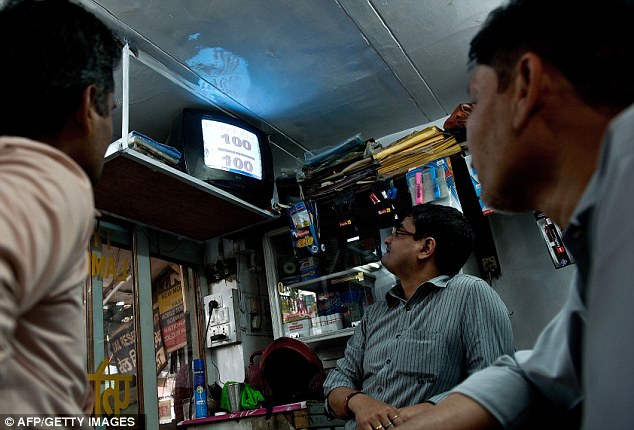
Shopkeepers let the customers watch the match from the shop indefinitely
There are common TV viewing holes in villages like the local tea-stalls, community centers, even movie theaters at times, a common TV in the square of the slum. Oh, there is no end to this kind of thing. These pictures to do the job of explaining the craziness cricket causes for the people of India and the rest of sub-continent countries (Pakistan, Sri Lanka and Bangladesh).
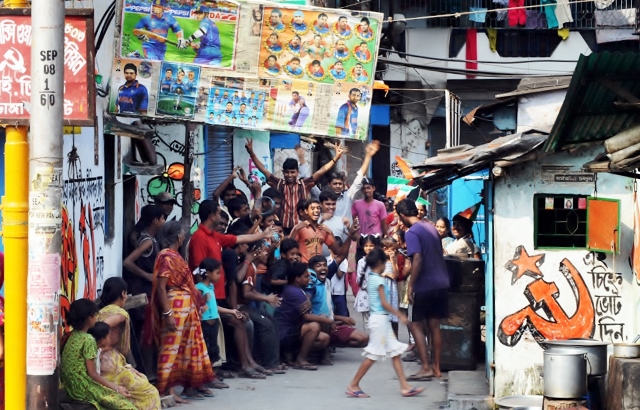
A tea stall hosting the TV viewing of the cricket match to a gathered crowd of the villagers
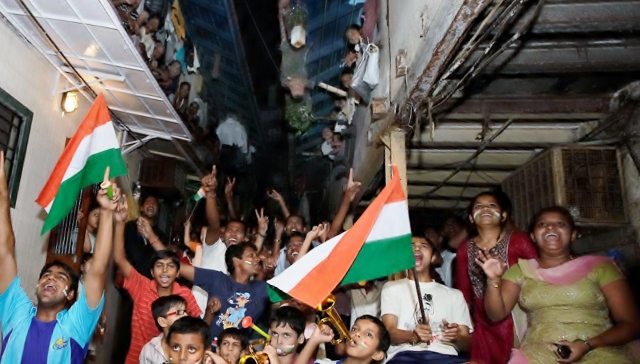
The slum dwellers watching the cricket match from a local TV-hole in the slums.

This is a mall in Kolkatta where the finals of the match between India and Sri Lanka is viewed.
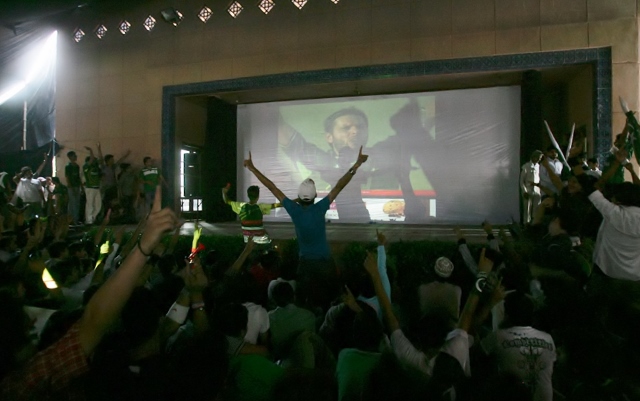
This is a movies theater in Karachi, Pakistan where cricket is telecast during the cricket season.
So, now coming back to the FIFA World Cup to be held in Brazil, all that I would say is that, the temperature is slightly lukewarm in comparison to the fever of the cricket playing nation.
Yes, we do talk a lot about it. But I guess that is about it. And, perhaps, some real football fans would watch it because they are really that – football fans.
By the way, did you catch Brazilian World Mom, Eco Ziva’s, post on the World Cup this week?
So what happens in your country? Is it a football-crazy country too? Or does your country live for some other sport?
Photo credit to the author, The Daily Mail and The Atlantic.
This is an original post to World Moms Blog written by Purnima Ramakrishnan, our Senior Editor from India.

by Melanie Oda (Japan) | Jun 5, 2014 | 2014, Japan, Parent Care, School
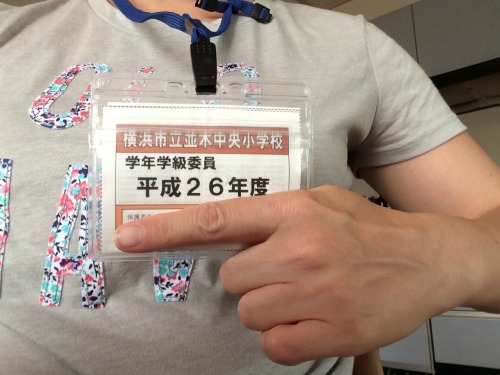
I have vague memories of the Parent Teachers Association (PTA) in the US, where I grew up. I remember the occasional school-wide meeting being held in the evening and a fall festival here, or there, involving baked goods. I’m not sure how much of my non-memory is due to just being an average kid (that is, extremely self-involved and just not noticing what the grown-ups were doing) or if the whole thing was just lower key.
Or, perhaps, my parents had some choice in the matter.
At any rate, PTA membership in Japan is by default. They take the fees out of your bank account right along with school supplies and school lunch payments. (Lunches her are amazing, by the way. A topic for another post.) I don’t know if it’s possible to opt out, or not. I certainly don’t know anyone who has tried!
The PTA at my children’s school is arranged like a pyramid, and at the top are the officers. Beneath them are the leaders of the four councils: class representatives, safety, and … well, in Japanese they call it “public information”, the group that makes the quarterly newsletter, along with the nomination committee. (These are the guys that try to suck you into being an officer for the next school year). Underneath that are the representatives from each class, and beneath all that is everyone else.
You are expected to serve on one of these councils at least once for each child.
This year, I ended up being the class rep for the first grade.
- Our job is to organize a school lunch “tasting day,” when parents can have lunch at school. But not with their child, in the Home EC room. (Both my daughter and I were disappointed by that.)
- Arrange and execute the washing of all the schools curtains. Twice. (I didn’t realize I should be washing my curtains at home twice a year….oops.)
- Collect and prepare for posting “bell marks,” the Japanese version of “Boxtops for Education,” collecting proofs of purchases that can be exchanged for school supplies.
- And lastly, mending the white smocks that children wear when distributing school lunches (in Japan, the children help prepare the lunch.)
Whew, that was quite a list!
Of course, all of these jobs require multiple letters sent home, which we prepare, and monthly meetings because … well, because this is Japan, perhaps.
Every family without fail is to volunteer for one of the tasks, either washing curtains, helping organize the bell marks, or mending the smocks.
When my oldest child started school, I was really surprised that the PTA were in charge of things that were so nitty-gritty.
I’m pretty sure, for example, the my mother never washed school curtains in her washing machine and then hauled them back to school to hang them up, still wet, after cleaning the school’s curtains rails.
So it makes me wonder …
What is PTA like in your country? Do you have to participate? What kind of things do you do?
This is an original post by our World Mom Melanie Oda from Japan.
Photo credit to the author.
If you ask Melanie Oda where she is from, she will answer "Georgia." (Unless you ask her in Japanese. Then she will say "America.") It sounds nice, and it's a one-word answer, which is what most people expect. The truth is more complex. She moved around several small towns in the south growing up. Such is life when your father is a Southern Baptist preacher of the hellfire and brimstone variety.
She came to Japan in 2000 as an assistant language teacher, and has never managed to leave. She currently resides in Yokohama, on the outskirts of Tokyo (but please don't tell anyone she described it that way! Citizens of Yokohama have a lot of pride). No one is more surprised to find her here, married to a Japanese man and with two bilingual children (aged four and seven), than herself. And possibly her mother.
You can read more about her misadventures in Asia on her blog, HamakkoMommy.
More Posts



























